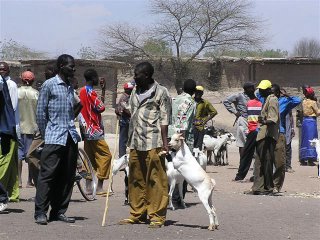

Market day at Munzi is Thursdays. It appears that it has been a major market since before the advent of industrial infrastructure. The crossroads it inhabits are much more conducive to bike and oxcart traffic which probably make up 95% of the vehicles that go there. Despite the beaten track being just that: a track, the market is one of the biggest I have seen outside of a major city. The town of Munzi lies some 30km from the tarmac/paved road and consists of no more than a row of typical African one roomed shops and service providers lining a couple hundred meters on both sides of a rutted path. There are power wires that we followed into town but we saw no evidence of electricity being in use once we were in the market. Our “cool” drinks came out of cool boxes and unfortunately I failed to get a picture of the bicycle driven butchers’ blades and knife sharpeners.
The biggest sections by far in the Munzi market were the areas devoted to the sale of animals and meat. The livestock area was teeming with animals and their handlers. Cattle, sheep and goats were the main offerings. A handler might be responsible for as few as one or two or as many as a dozen or more animals. Impressions in the earth that serve as pens might have been dug manually or were simply worn in by dozens of generations of herds being brought to this place to sell. This is not a place for the faint of heart or a vegetarian. Animals were being rather roughly handled and expertly but painfully penned and otherwise restrained. The cattle in particular sported rather evil yet artful scarification that serves for identification and decoration.
We were after fresh meat -- lamb to be specific. We were given to understand that excellent quality and prices would be worth the drive. Our information on getting there was sketchy: take a left off the road just past a magnificent baobab half way between Mwadui and Shinyanga and keep left. We’d find the market just over a “major” bridge. One flat tyre (or puncture as these events are known around here), one debate over the size of an intervening bridge and an hour to cover the 30km of washboard ridged track and we were there.
We spent about an hour looking around and seeking out an interpreter to help with the negotiation for meat. Our interpreter led us to the butchering section of the market. While the sight that met us was not entirely pleasant to the eyes or nose, it is probably the best place to get fresh meat in this area or in any place where refrigeration (and especially refrigerated transport) is hard to come by. This market’s methods are probably as old as the practice of selling meat at market. Entire freshly butchered carcasses hung from racks made of makeshift poles. Hooves and tails were left on pieces in order to ease identification of the type of meat. The heads and offal meat of the creatures was offered separately on small platforms. To our pleasant surprise, each butchered beast’s lungs, kidneys and liver were inspected by a roving government meat inspector.
With the aid of the interpreter, Kobus negotiated for two sheep to be slaughtered; one to roast whole on a spit and the second to be cut into manageable pieces for the braai (BBQ) or oven. The entire order would cost less than C$30. We adjourned to a bar with a view of the butcheries to have the aforementioned warmish drink and await the preparation of our beasts. It felt like a very civilized and relaxing way of going about one’s shopping.
Unfortunately, the morning ended on a sour note as I fell victim to another of the age old characters of any market – the pickpocket. Kobus had gone to move the truck to an advantageous spot and I wandered after the couple we were with as they followed our interpreter back into the textiles section on a hunt for some Masai blankets. Suddenly I was stopped and quite effectively isolated from my friends by a couple seemingly friendly young men who were interested in looking at my baby. I should have clued in that they were not the usual curious women. As I was distracted by my mothers’ instinct to watch hands reaching for Simon, I felt the hand reach into my pocket and then the culprits were gone with my money, shielded by the fabrics and clothes draped over lines all around us. A crowd gathered a gaped as the muzungu (white foreigner) with the baby stood there and yelled but to no avail. My money was gone, my ego bruised but Simon and I were otherwise fine, which is of course the important thing. In hindsight, I have to admire Simon’s composure as his mother stood amongst a crowd of strangers and completely lost her composure. A few moments of miserable searching and I was back in the supportive and protective company of my husband and friends. The discussion of the event served to divert our attention from the discomforts of the return trip on the rutted path back to the paved road and we were quickly home in Mwadui.

No comments:
Post a Comment